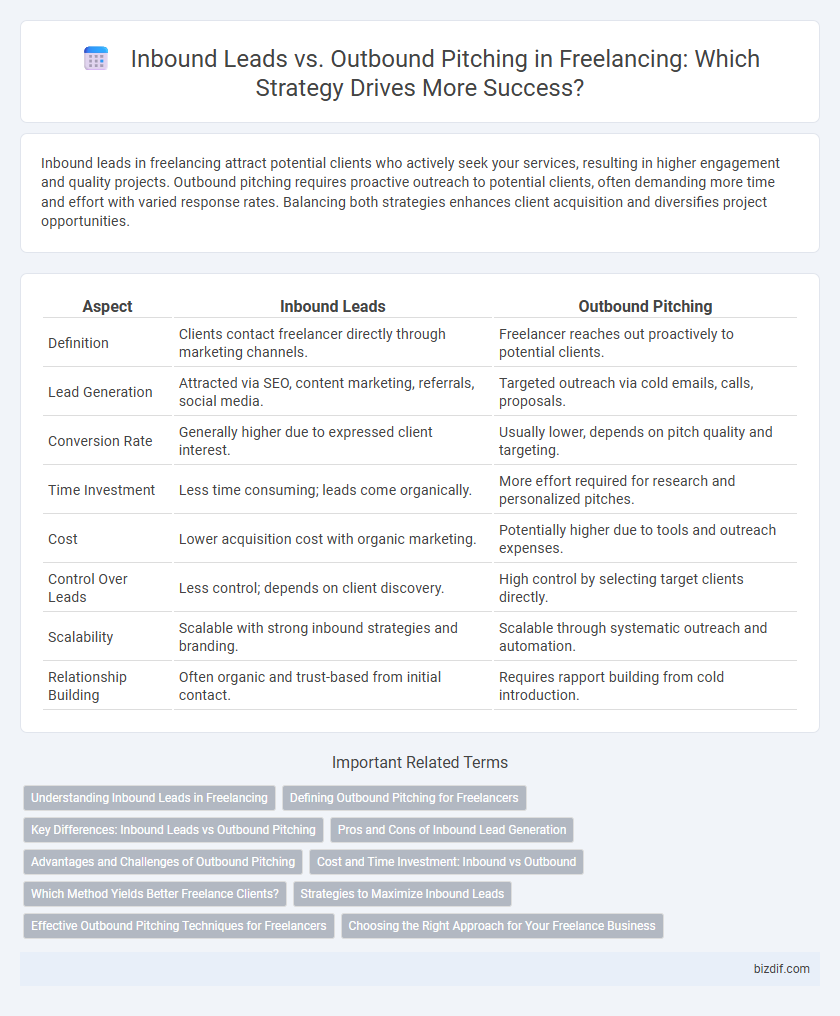Inbound leads in freelancing attract potential clients who actively seek your services, resulting in higher engagement and quality projects. Outbound pitching requires proactive outreach to potential clients, often demanding more time and effort with varied response rates. Balancing both strategies enhances client acquisition and diversifies project opportunities.
Table of Comparison
| Aspect | Inbound Leads | Outbound Pitching |
|---|---|---|
| Definition | Clients contact freelancer directly through marketing channels. | Freelancer reaches out proactively to potential clients. |
| Lead Generation | Attracted via SEO, content marketing, referrals, social media. | Targeted outreach via cold emails, calls, proposals. |
| Conversion Rate | Generally higher due to expressed client interest. | Usually lower, depends on pitch quality and targeting. |
| Time Investment | Less time consuming; leads come organically. | More effort required for research and personalized pitches. |
| Cost | Lower acquisition cost with organic marketing. | Potentially higher due to tools and outreach expenses. |
| Control Over Leads | Less control; depends on client discovery. | High control by selecting target clients directly. |
| Scalability | Scalable with strong inbound strategies and branding. | Scalable through systematic outreach and automation. |
| Relationship Building | Often organic and trust-based from initial contact. | Requires rapport building from cold introduction. |
Understanding Inbound Leads in Freelancing
Inbound leads in freelancing refer to potential clients who initiate contact after discovering a freelancer's profile, portfolio, or content through search engines, social media, or referrals. These leads often indicate higher intent and quality since clients actively seek the freelancer's expertise, reducing the need for cold outreach. Optimizing online presence with targeted keywords, showcasing successful projects, and maintaining client testimonials enhances inbound lead generation and increases conversion rates.
Defining Outbound Pitching for Freelancers
Outbound pitching for freelancers involves proactively reaching out to potential clients through direct emails, cold calls, or social media messages to secure projects. This strategy requires targeted research to identify ideal clients and craft personalized proposals that highlight relevant skills and past work. Effective outbound pitching increases visibility and opportunities, especially in competitive freelancing niches where inbound leads alone may be insufficient.
Key Differences: Inbound Leads vs Outbound Pitching
Inbound leads in freelancing originate from potential clients actively seeking services, often resulting in higher conversion rates due to pre-existing interest and trust built through content marketing or referrals. Outbound pitching involves freelancers proactively reaching out to potential clients via cold emails, calls, or proposals, requiring more effort and persistence with typically lower immediate response rates. The key differences lie in the lead generation approach, client engagement dynamics, and overall efficiency in securing projects.
Pros and Cons of Inbound Lead Generation
Inbound lead generation in freelancing attracts potential clients actively seeking services, resulting in higher-quality leads and often better conversion rates. It reduces time spent on outreach, allowing freelancers to focus more on project delivery and skill development. However, it requires consistent content creation and SEO efforts, which can delay lead flow and may lead to unpredictable income streams compared to proactive outbound pitching.
Advantages and Challenges of Outbound Pitching
Outbound pitching in freelancing offers the advantage of direct control over client targeting, allowing freelancers to proactively reach specific industries or companies aligned with their skills. This approach often accelerates lead generation compared to waiting for inbound leads, increasing opportunities to pitch tailored proposals. However, outbound pitching demands consistent effort, effective communication skills, and resilience to rejection, presenting challenges in maintaining motivation and securing quality responses.
Cost and Time Investment: Inbound vs Outbound
Inbound leads typically require lower cost and time investment, as potential clients discover freelancers organically through content marketing or referrals. Outbound pitching demands higher expenditures on targeted outreach strategies and personalized proposals, consuming considerable hours to research and engage prospects. Efficient freelancing growth hinges on balancing inbound lead generation's cost-efficiency with outbound pitching's proactive client acquisition.
Which Method Yields Better Freelance Clients?
Inbound leads often yield better freelance clients due to higher engagement rates and a pre-existing interest in services, resulting in more qualified and motivated prospects. Outbound pitching requires significant effort and persistence, often facing lower response rates and less targeted audiences. Data shows freelancers leveraging inbound strategies experience a 30% higher conversion rate compared to outbound outreach campaigns.
Strategies to Maximize Inbound Leads
Maximizing inbound leads in freelancing involves creating a strong online presence through optimized portfolios, targeted SEO keywords, and engaging content that addresses client needs. Leveraging social proof such as testimonials and case studies enhances credibility, attracting more qualified inquiries organically. Consistent engagement on professional networks and strategic use of lead magnets like free resources or webinars can significantly boost inbound lead generation.
Effective Outbound Pitching Techniques for Freelancers
Crafting personalized outbound pitches tailored to a freelancer's target client significantly increases response rates and project acquisition. Leveraging platforms like LinkedIn and industry-specific job boards enables precise targeting and timely follow-ups, enhancing engagement. Clear value propositions, concise messaging, and demonstrating past project success are key elements that elevate outbound pitch effectiveness in freelancing.
Choosing the Right Approach for Your Freelance Business
Inbound leads generate higher-quality prospects by attracting clients through content marketing, SEO, and social proof, reducing time spent on client acquisition. Outbound pitching involves proactively reaching out to potential clients via cold emails, calls, or social networks, offering more immediate but often lower-conversion opportunities. Freelancers should evaluate their niche, resources, and business goals to balance inbound strategies for sustainable growth and outbound methods for quick wins.
Inbound leads vs Outbound pitching Infographic

 bizdif.com
bizdif.com